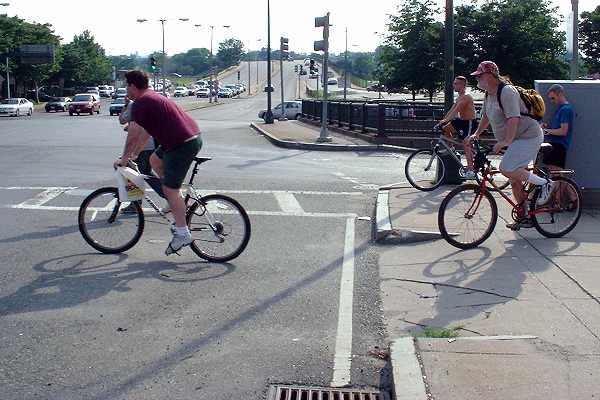
Top: Home Page
Up: Table of Contents
Previous:
Next:
The section of path between Cambridge Street and Western Avenue in Allston is one of the most substandard anywhere along the Charles River. At Cambridge Street, this section starts with a crosswalk that lacks a curb cut. Or rather, the curb cut is not where the crosswalk is. The curb cut was apparently installed so that a police cruiser can park on the wide sidewalk when an officer as assigned to direct traffic, as is usual during the evening rush hour. |
Cambridge Street: curb cut here, crosswalk there, 2003.
Also note the parallel bar storm grating in the foreground.

The path, marked with a dashed centerline, threads its way between lampposts and a signal control box, and connects with the crosswalk at the missing curb cut. There is always conflicting traffic at this crosswalk. The least conflict occurs when traffic turns right from the Storrow Drive offramp (at the rear in the photo below) but path users traveling away from the camera position have no traffic signal whatever. Path users traveling toward the camera can see the traffic signal for the roadway, but this gives only a short amber signal to indicate that heavy cross traffic (as seen in the photo) is about to start moving. As of 2001, there is no walk/don't walk signal at this crosswalk, in either direction. |
Another view of crossing at Cambridge Street, 2001
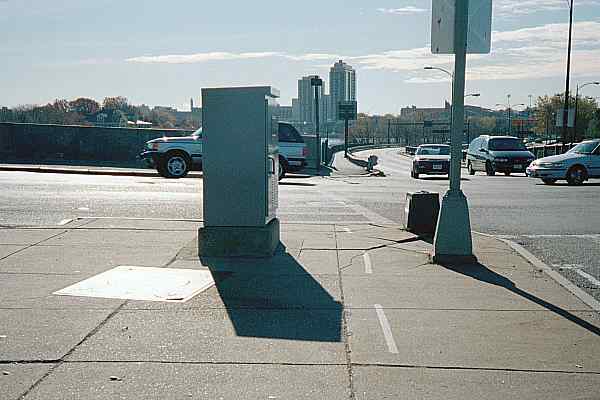
Below -- too-typical crossing conditions at the
evening rush hour. The car at the right
in the photo has swerved
to avoid the cyclist.
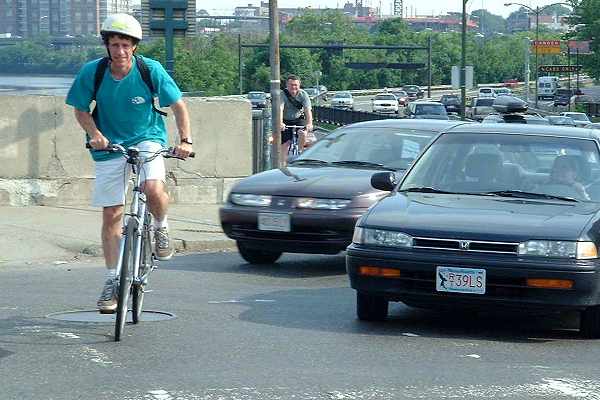
| The crosswalk has been moved in recent years. At one time, crosswalk markings extended diagonally across the Western Avenue bridge, to connect with the oddly-placed curb cut (photo below taken in 1982). Notice that in this photo, the curb cut on the far side of the bridge, where the bicyclist is about to enter the crosswalk, is around the corner. Path users like the ones in the photo below had to turn the corner before they moved out into the crosswalk. Right-turning drivers would expect the bicyclists to stay on the sidewalk once they started around the corner, or might not see them at all -- especially, not children, who would be entirely hidden behind the concrete railing of the bridge. |
Diagonal crosswalk at Cambridge Street, 1982
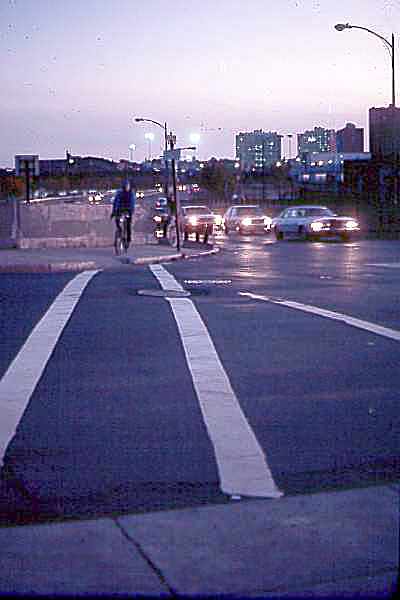
| Now, let's turn around and look down the path. The path between Cambridge Street and Western Avenue is really only a narrow sidewalk. On one side is a curb, and on the other side, a low guardrail, assuring that that a bicycle which strays into it will topple over it, and that a motor vehicle which strays onto the path will be guided along it, taking out anyone who happens to be walking or riding there. Many westbound bicyclists choose to ride in the roadway here. Eastbound bicyclists do not have this option. Traffic is relatively light, as this is only a frontage road. Reducing the frontage road to one lane would allow a more reasonable amount of room for the path. |
Path between Cambridge Street and Western Avenue, 2003
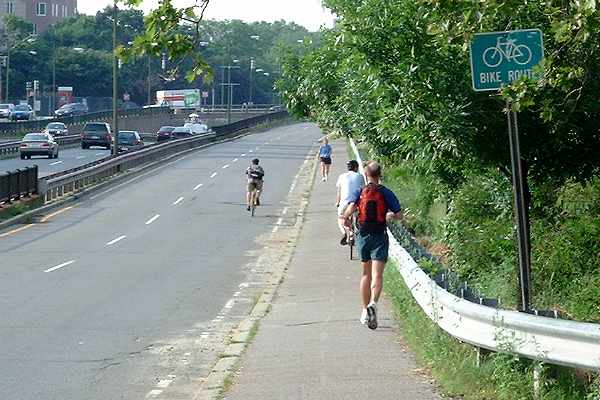
| During construction in late 2003 and early 2004, a barrier was placed in the frontage road, narrowing it to one lane and making the point that this had adequate capacity. Vehicles might queue at the Western Avenue end, shown below, but the embankment is wide at this end -- note the construction material stored on it -- and there is plenty of room at this end to widen the path while allowing two lanes for the frontage road. |
Frontage road approaching Western Avenue intersection
during construction, spring of 2004.
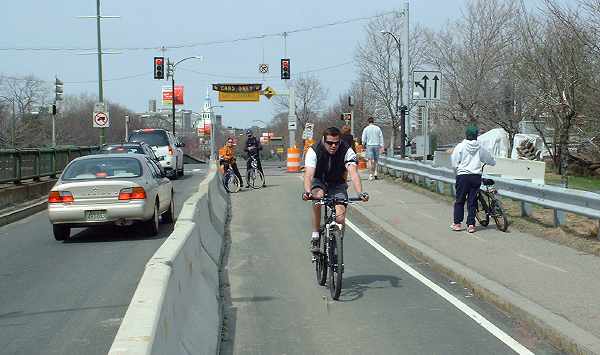
| At the Western Avenue intersection, pedestrian signals have been installed. The photo below looks back from west to east across the Western Avenue bridge. The narrow path inside the guardrail is visible in the background, behind the bicyclist who is crossing against the light. Notice that motor vehicles are also crossing. They have the green light. The crosswalk is operated by pushbuttons, and many path users do not bother with the rather long wait for signals to change. Motorists may turn right on red from the bridge (left) unless the crosswalk signal is in its "walk" phase. |
Looking across Boston end of Western Avenue Bridge, 2001.
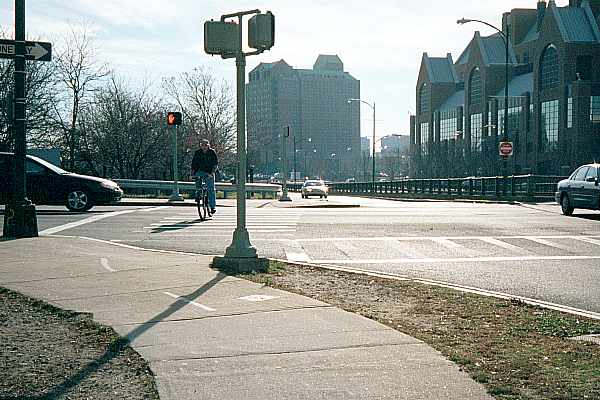
| The photo below was taken at the same location in 1982. At that time and for many years later, there were no signals for the crosswalk. The bicyclist is crossing through moving traffic. |
Looking across end of bridge, 1982
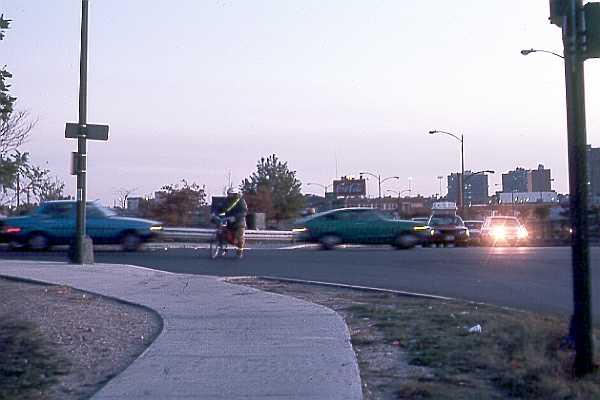
| The Western Avenue bridge is one-way from Cambridge toward Boston. Western Avenue in Boston is two-way, but vehicles headed toward the bridge must turn right onto a frontage road. As shown in the photo below, taken in 1982, there was for many years no designated or improved way to get to the path from Western Avenue, except by crossing to the west sidewalk. |
Western Avenue approaching bridge from Boston side, 1982
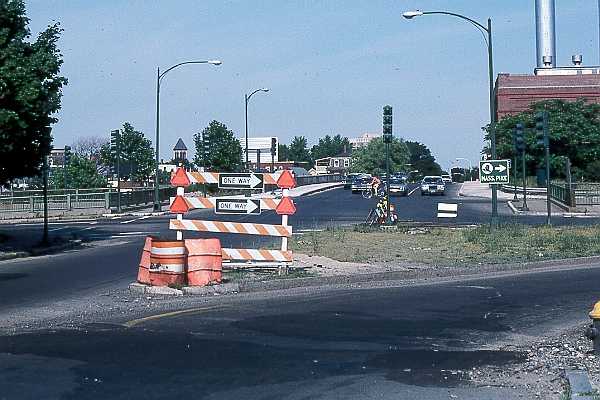
| In recent years, the intersection has been improved, with additional crosswalks, as shown in the photo below. It is now possible to cross to the path and the bridge as a pedestrian, though this requires waiting for three separate pushbutton-operated signals. |
Crosswalks at Western Avenue Bridge, 2001
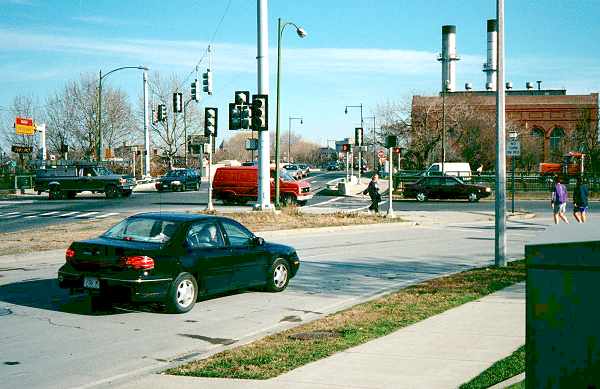
What should happen hereThe frontage road is overbuilt. It serves only westbound traffic from Cambridge Street onto Soldier's Field Road and Western Avenue, which is rare. The frontage road could be cut back to one lane, allowing the path to be wider. The intersection of Cambridge Street and Solder's Field Road needs a redesign. If the on-ramp from the Massachusetts Turnpike were pulled back to enter Cambridge Street sooner, there would be more room for vehicles to queue, without a separate signal phase. The recently added exit from the hotel on the corner of Cambridge Street and Soldier's Field Road further delays traffic in the intersection and might be relocated (for example, to merge into the Turnpike ramp) so it does not require its own signal phase. |
Striping on Cambridge Street approaching the
bridge -- one left lane becomes two,
two right lanes become one,
like something out of Mad Magazine! Also, the traffic
that merges from the right should
merge sooner.
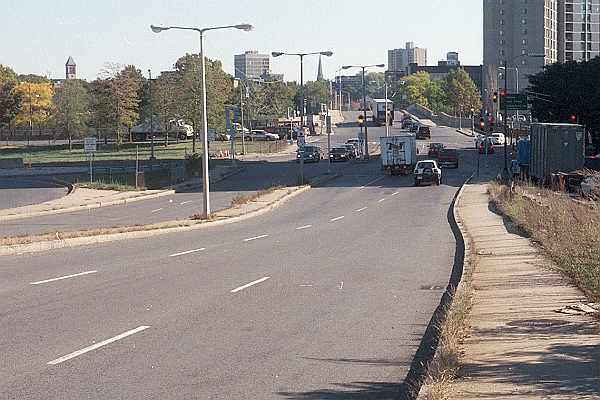
| The path at least should have signals at this intersection but a grade separation
would be preferable. The intersection with Western Avenue could be improved by including a contraflow lane on Western Avenue, leading away from the camera in the island in the photo above, so that cyclists might cross to the path on a single signal phase. At present, many cyclists cross to the left sidewalk before the intersection to access the path. |